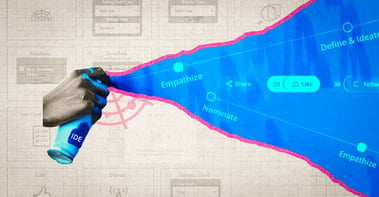Open innovation offers many great opportunities for organizations to generate diverse, resilient, and innovative ideas. However, many challenges can arise with open innovation if you are not clear about your desired outcomes and the processes required to achieve them. Applying the right innovation management tools and methods to overcome these challenges can make the open innovation process much more collaborative, streamlined, and effective. In this blog, we will unpack the most common challenges in open innovation and explain how to tackle them.
Open innovation has received increasing attention from companies in recent years as a collaborative approach to problem-solving. Opening up the traditional innovation process and sourcing ideas and solutions from a wide range of external audiences can be a cost and time-efficient way to improve existing or develop new products and services.
Submissions for open innovation campaigns can include ideas around specific challenges or opportunities, proposals from potential startups and partners, and direct input from customers. However, the approach may prove ineffective or a waste of time if certain prerequisites or conditions are not met.
Based on our years of experience with clients looking to integrate open innovation into their innovation activities, we have compiled a list of challenges many teams face when applying open innovation in their organizations.
1. Lack of clear goals for open innovation
For successful open innovation endeavors, it is imperative that you have clearly defined goals for open innovation projects to be able to measure success and build trust within the organization. Without clear goals, it is difficult to set direction and motivate others in the company to participate. You have to define:
- Objectives: What do you want to achieve with an open innovation initiative? Do you want to identify disruptive solutions for specific search fields or new ideas to improve existing offerings? Or are you looking for collaboration opportunities with startups? Who is your target group; are submissions limited to the company's customers and partners or extended to the general public?
- Ownership: Who is responsible for digesting promising idea submissions further?
- Problem: What problem do you want to solve with an open innovation initiative?
- Timeline and milestones: Is the open innovation challenge always-on (constantly offering externals the opportunity to submit proposals) or time-bound (your campaign has an end date by which you would like to receive as many proposals as possible)? Are there milestones or different phases?
The German engineering and technology company Bosch, for instance, had a very clear goal when launching the Bosch Open Innovation Partnerships platform. They aim to receive outside-in perspectives for defined search fields relevant to their strategic direction and co-create with startups, universities, and other experts. It allows them to access and coordinate idea submissions easily.
To identify relevant ideation search fields and ensure that the scope of your open innovation project is not too narrow or broad, we recommend starting with trend, technology or startup scouting. It helps to identify and monitor drivers of change in your business environment.
Collaborative ratings and trend, technology, or startup radars will then help you discover opportunity or risk areas from your environmental scanning activities. It also contributes to internal alignment on where to focus your innovation strategy.
Based on the gained insights, you can use open innovation campaigns to generate ideas and solutions quickly or to identify potential collaboration partners for relevant areas.
Software tools that will help you succeed: ITONICS Insights, ITONICS Radar
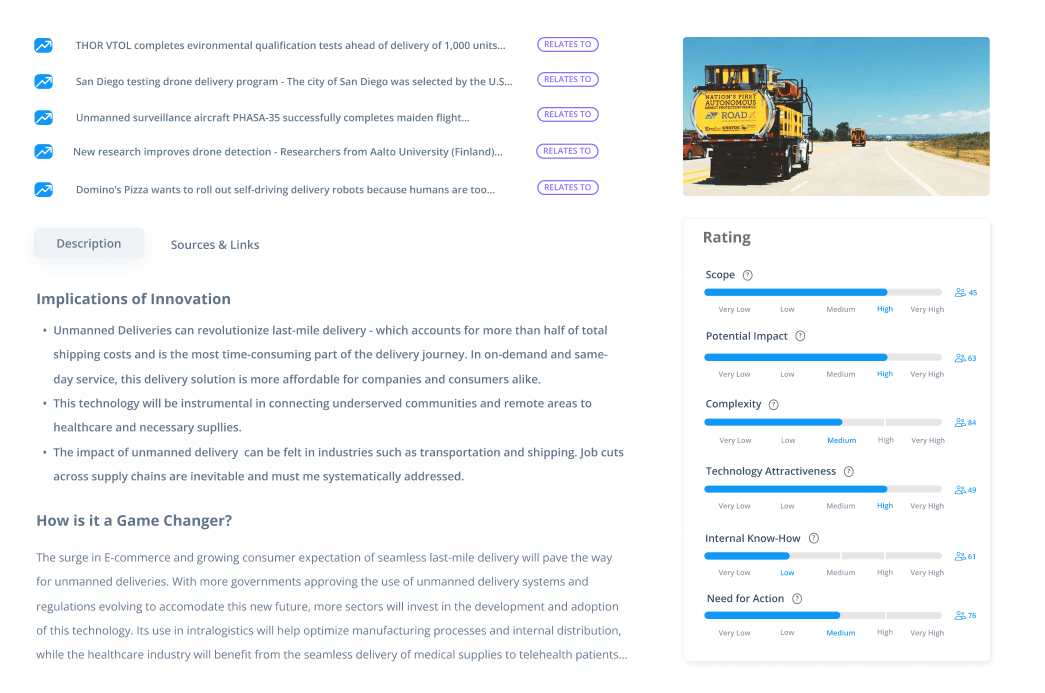
2. Lack of commitment from internal stakeholders
When it comes to open innovation efforts, companies often experience cultural challenges and a lack of commitment from internal stakeholders. Ideas or solutions that do not come from in-house often harbor the problem of the "not invented here" syndrome, which means they may not be accepted or viewed critically.
If individuals feel that they cannot contribute their own ideas but instead have to source ideas from somewhere, they may feel disengaged or discouraged. This can result in innovation blockades within a company, impeding the progress and output of your open innovation initiatives.
To counteract this, consider the innovation culture in your organization. If outside-the-box thinking and open innovation are encouraged by the top management, it can help foster a more open mindset.
Moreover, you can collect idea submissions internally from your intrapreneurs around the globe as well as external sources. Connect open innovation initiatives with existing innovation projects on your platform by enabling experts outside of your organization to contribute ideas through submission forms.
Nudging and gamification (such as providing rewards and competitive ranking systems) on an open innovation platform are effective techniques to improve efficiency, increase employee engagement, and foster collaboration in an open innovation campaign.
Involving internal experts and stakeholders in evaluating external idea proposals can also be an effective way to encourage participation and commitment, helping to overcome cultural challenges. To promote participation throughout the organization and create transparency, sending out regular newsletters can be beneficial.
Software tools that will help you succeed: ITONICS Campaigns, External Gateways in ITONICS
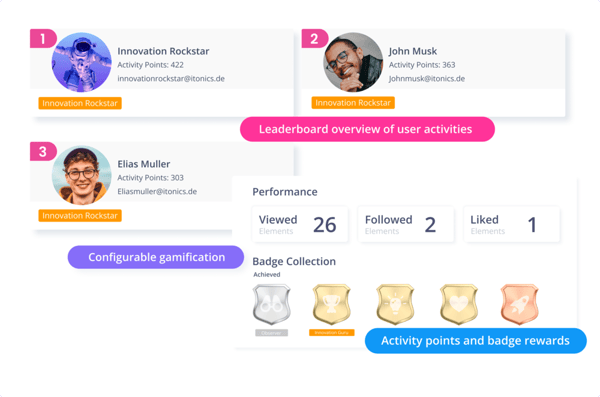
3. Raise awareness for open innovation challenges and address the right audience
The most elaborate open innovation initiative won't help you if you don't receive enough (valuable) submissions. And to achieve that, you need to figure out how to reach and engage the right external audience.
You first need to consider who you want to receive proposals from (startups, partners, customers, students, or other individuals). Then you have to decide which communication channels to use to raise awareness for your open innovation campaign and what information you need to provide to point idea submitters in the right direction.
Instead of limiting external communication only to your corporate website, you can think about the following additional channels for promoting your open innovation campaign:
- Keep your followers on social media (primarily LinkedIn) posted with regular updates and calls for participation. Ask your colleagues to spread the word by sharing posts on their private social media channels. You can also post your campaign in relevant LinkedIn groups to raise awareness.
- Use conferences or trade fairs as a platform to promote ongoing initiatives since there is a great density of experts.
- Reach out to your customers through email newsletters and motivate them to participate.
- Contact universities and ask them to communicate your open innovation initiative and provide benefits beyond idea submission, for instance, the opportunity for co-creation and building new skills.
To motivate external audiences to submit ideas, you can think about a reward system to provide incentives.
In order to get idea submissions from the right target group, you also have to consider what information you want to provide in the external submission forms.
Software tools that will help you succeed: External Gateways in ITONICS
This feature makes open innovation campaigns accessible to external users. Presented as a landing page, the External Gateway form is made accessible for participants and contributors via a link. This link can be integrated into other sites and web pages, e.g. your corporate website. The feature is highly configurable; for example, you can insert videos into your forms to provide additional information to potential submitters.
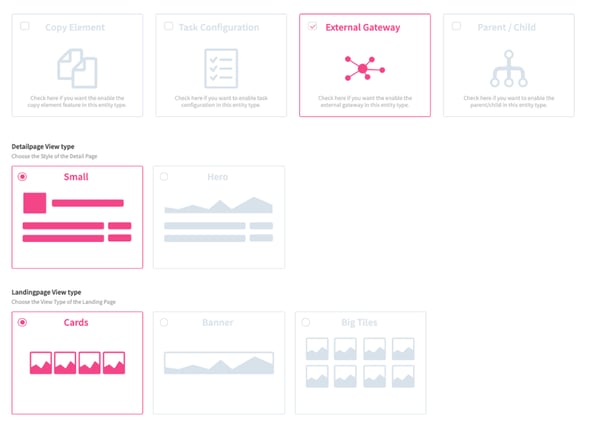
4. Keep idea submission forms simple
There is a fine line between requesting enough information to help evaluate submitted ideas afterwards and requesting too much information from your external audience. Our experience has shown that if the form is too lengthy, complicated, or requires a lot of time and effort to complete, people are more likely to abort the submission process.
When planning an open innovation campaign, don't neglect to think about the design of the submission forms. Consider with other internal stakeholders what information is required and what to focus on to keep the forms short and simple.
External Gateways in the ITONICS Innovation OS make it easy for you to configure the submission forms according to your needs and use case.
5. Manage and coordinate a large number of submissions
Another challenge that often arises is that it can become difficult to keep track of and coordinate a large number of idea proposals. You need a proper process in place to identify and move forward with the most promising ones, for instance, by defining phases the ideas have to go through.
Having a single source of truth where you can collect ideas and make them accessible to internal and external stakeholders for collaborative evaluation and enrichment is the foundation of an effective open innovation campaign.
Tools that will help you succeed:
ITONICS Campaigns is a software tool that supports ideation challenges and the management of idea submissions with configurable workflows. Moreover, the Rating feature allows you to evaluate ideas with other internal stakeholders based on defined criteria.
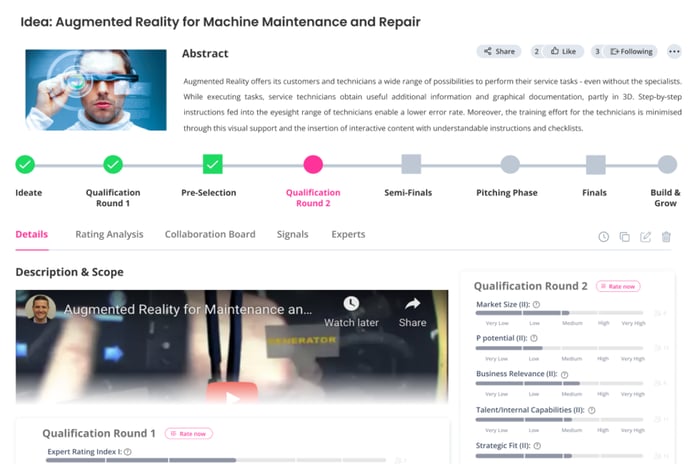
Externally submitted ideas run the risk of falling short in quality or not aligning with defined goals. To filter out such submissions in the first step, regular quality checks must be made using clearly defined criteria, such as language, precision, and richness of explanations.
This task should be performed by a dedicated team or a responsible person to facilitate the subsequent selection process. While these are primarily internal teams or individuals, some organizations assign the task of evaluating ideas to a third-party research firm to eliminate bias in the process.
Moreover, you have to define clear evaluation criteria to ensure that the most relevant ideas are chosen for further development or collaboration with open innovation partners.
A famous example where the criteria were not set correctly in the evaluation process is Netflix. They launched an open innovation challenge in 2006 to find a filtering algorithm that improves suggestions of movies and series for users by 10% compared to their existing one. In less than three years, a winner was selected whose algorithm improved the suggestions by over 10%. However, they realized afterwards that the winning algorithm was too costly to engineer. Netflix then used an algorithm from the runner-up group, whose improvement rate was “only” 8.43%. If the required resources had been considered in advance, time and money would have been saved.
It is vital to provide clear guidelines and criteria to identify the most promising ideas. Factors such as Business Relevance, Strategic Fit, Internal Capabilities, Time to Market, Cost of Implementation, etc. can be considered for the evaluation process. The configurable Ratings in the ITONICS Innovation OS allow you to define the criteria according to your needs.
Also see: Mechanisms to Identify Valuable Ideas Fast in Open Innovation
6. Further digest qualified ideas from your open innovation initiative
Once you receive external ideas and they have gone through the qualification phase, the ideas need to be passed on to someone who can process and utilize them further. A common challenge companies often face in open innovation is that ideas do not find a "home" in the company and are not developed further.
One reason could be that there is no clear stakeholder upfront who actively seeks an outside-in perspective and disruptive solutions. Innovation teams often try open innovation because everyone else is doing it and seeing what comes of it. This, however, often ends up in ideas not being further pursued, which, in turn, leads to frustration of employees and external partners (as well as wasted time).
The governance surrounding your open innovation challenges is critical. Define clear responsibilities in advance based on the problem that has to be solved to ease the flow of ideas and information into the organization. Assign the phases an idea has to go through to specific people to ensure the right stakeholders are involved from the beginning. Moreover, make sure to prioritize proposals based on certain criteria.
Software tools that will help you succeed: Portfolios or Matrix Visualizations in the ITONICS Innovation OS help you prioritize the right ideas or partnerships to decide which ones to pursue further. Manage project portfolios using Kanban boards and move from planning to implementation with transparency and governance in mind.
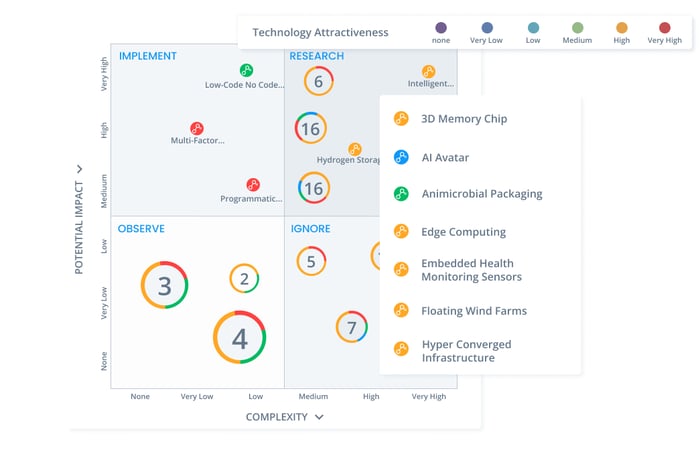
How ITONICS helps establish a successful open innovation process
With proper planning and execution, open innovation can be invaluable for generating new ideas and driving innovation. Finding the right platform to manage your open innovation projects is one of the factors for a successful open innovation process. The right tools can help you to reach your goals faster and more efficiently.
The ITONICS Innovation OS is an end-to-end innovation management software, allowing organizations to integrate open innovation with other innovation projects and manage submissions on one platform. Our tools also support outside-in startup scouting to discover collaboration opportunities.
With our open innovation software solution, you can collect idea submissions, evaluate them collaboratively with other internal stakeholders, and prioritize the most important ideas and projects for further development. Moreover, the platform enables you to organize and structure project information to provide quick views on objectives, risks, workflows, budgets, and KPIs.
If you want to see for yourself how ITONICS can support your open innovation initiatives, get a free demo!


